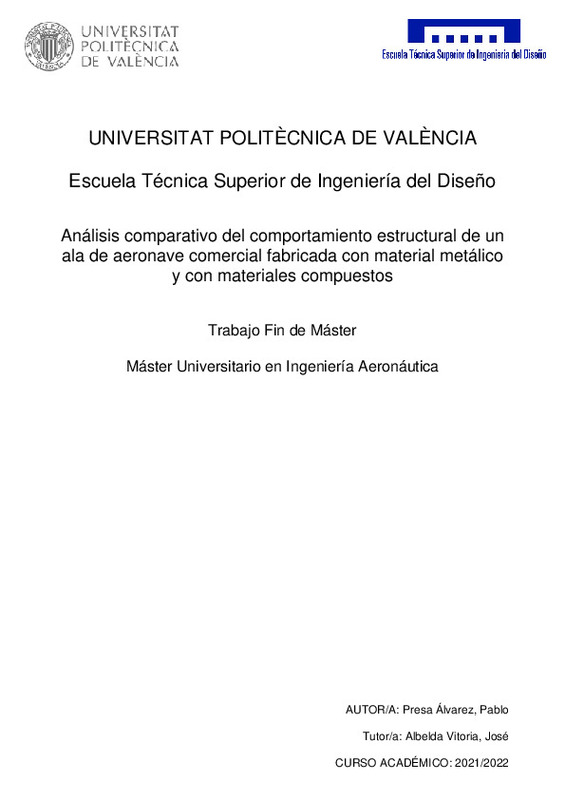|
Resumen:
|
[ES] En este proyecto se ha buscado comprobar las supuestas ventajas en el comportamiento estructural que ofrece el uso de materiales compuestos en una industria como la aeronáutica, concretamente en los elementos que ...[+]
[ES] En este proyecto se ha buscado comprobar las supuestas ventajas en el comportamiento estructural que ofrece el uso de materiales compuestos en una industria como la aeronáutica, concretamente en los elementos que componen el ala. En primer lugar, se definirán los parámetros y componentes típicos que caracterizan un ala para poder llevar a cabo un modelo de esta. Se optará por utilizar una serie de medidas usuales en un ala genérica de aviación civil para poder diseñar un modelo CAD tridimensional que constará de revestimiento, costillas, largueros y rigidizadores. Para esta labor se hará del software de diseño asistido por ordenador CatiaV5. Una vez realizado dicho modelo, se exportará en un formato compatible con un programa de análisis estructural. En este caso se utilizará ANSYS Clásico o APDL. Las correspondientes líneas, áreas, volúmenes y demás elementos serán importadas en dicho software, donde se modificará cuidadosamente el modelo hasta conseguir una continuidad total entre sus elementos. Una vez estructurado el modelo, se estudiarán dos casos. El primero consistirá en un ala constituida de los materiales metálicos más comúnmente utilizados en la industria mientras que en el segundo se sustituirán ciertos elementos metálicos por materiales compuestos típicamente utilizados. En ambos modelos se mallará de forma adecuada acorde a lo requerido por el modelo y se definirán detalladamente las condiciones de contorno básicas a las que se ve sometida un ala. Las cargas fundamentales que se van a utilizar serán las cargas aerodinámicas variables (aplicadas mediante un método de segmentación), el peso del combustible de los depósitos del ala y las cargas del propulsor. Finalmente, obtenidos los resultados se compararán los valores obtenidos en cada modelo para comprobar las mejoras conseguidas gracias al material compuesto
[-]
[EN] This project has sought to verify the supposed advantages in structural behaviour offered by the
use of composite materials in the aeronautical industry, specifically in the elements that make up the
wing.
First ...[+]
[EN] This project has sought to verify the supposed advantages in structural behaviour offered by the
use of composite materials in the aeronautical industry, specifically in the elements that make up the
wing.
First of all, the typical parameters and components that characterize a wing will be defined
in order to carry out a model of it. It will be decided to use a series of usual measures in a generic civil aviation wing to be able to design a three-dimensional CAD model that will consist of
skin, ribs, spars and stiffeners. For this task, the CatiaV5 computer-aided design software will be used.
When the model is made, it will be exported in a format compatible with a structural analysis
program. In this case ANSYS Classic or APDL will be used. The corresponding lines, areas, volumes
and other elements will be imported into this software, where the model will be carefully modified
until total continuity between its elements is achieved. Once the model is structured, two cases will
be studied. The first will consist of a wing made of the most commonly used metallic materials in
the industry, whereas in the second some metallic elements will be replaced by typically used composite materials. In both models, it will be meshed appropriately according to what is required by
the model and the basic boundary conditions which a wing is subjected will be defined in detail. The
fundamental loads to be used will be the variable aerodynamic loads (applied using a segmentation
method), the fuel weight of the wing tanks, and the propellant loads.
Finally, when the results have been obtained, the values obtained in each model will be compared
to check the improvements achieved thanks to the composite material
[-]
|







